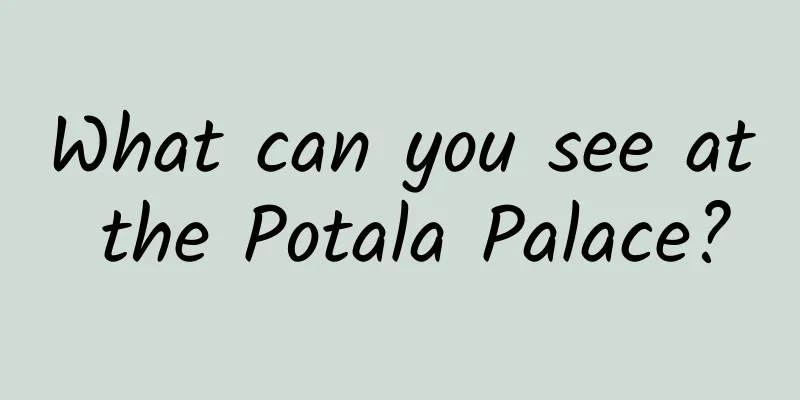What can you see at the Potala Palace?

|
Potala Palace, Tibet Seems to be out of touch with the real world It is accompanied by pure ice and snow Located on the highest plateau in the world (Potala Palace in Tibet, photographer @Pu Qiong) ▼ It is made of the most precious materials and the most exquisite craftsmanship. Considered the abode of gods (Please watch in horizontal mode, schematic diagram of the interior and exterior of the Potala Palace, drawn by @谢统凯&@李天一&冯艺卓/Planetary Research Institute) ▼ It transcends the mountains It is the holy temple in the dreams of all Tibetans. It is called the "highest point in Tibet" (Potala Palace location diagram, map by @吴昕恬/Planet Research Institute) ▼ As we approached the Potala Palace What will you see? I think that's The condensed history of the Qinghai-Tibet Plateau It is also the wisdom, hope and tragedy of all living beings on the Qinghai-Tibet Plateau. Potala Palace See the sky, see all living things 01 origin Qinghai-Tibet Plateau The highest place on Earth It is called the roof of the world The Third Pole Harsh living environment on the plateau Let people rely on the protection of gods Tibetan ancestors believed that all things have spirits I think every mountain, lake They are all gods who protect themselves (Please watch horizontally, Mount Kailash, the first sacred mountain in Tibet, photographer @南卡) ▼ By the 7th century AD Indian Buddhism began to spread in the Qinghai-Tibet Plateau It is integrated with the Bon belief that all things have spirits. Evolved into Tibetan Buddhism with local characteristics Over time Tibetan Buddhism is widely accepted The idea of the immortality of the soul and the six realms of reincarnation Tibetan Buddhism has become the main belief on the plateau And derived the four major sects of Tibetan Buddhism (The four major sects of Tibetan Buddhism. Tibetan Buddhism believes that the soul will continue to reincarnate in the six realms of gods, asuras, humans, animals, hungry ghosts, and hell. Map by @冯艺卓/星球研究院) ▼ By the 17th century AD The Gelugpa sect of Tibetan Buddhism is the most powerful With the joint support of the Qing court and the Mongolian tribes The Fifth Dalai Lama, leader of the Gelugpa sect Became the religious leader of Tibet At that time Tibet needs a new political and religious center It is located in Lhasa. (A mural depicting the Fifth Dalai Lama's audience with Emperor Shunzhi. The Fifth Dalai Lama was officially canonized by the Qing court as "The Dalai Lama, the Great and Free Buddha of the Western Heaven, the Leader of the Buddhist Teachings of the World", thus formally establishing the Dalai Lama's position as the leader of Buddhism in Tibet. Image source: @wikimedia commons) ▼ Lhasa is the most fertile land in Tibet It is surrounded by mountains on all sides, providing a natural barrier. The river is winding and has fertile river valley plains As early as the first half of the 7th century AD Songtsen Gampo inherited the business pioneered by his father and grandfather Created the unprecedentedly powerful Tubo Dynasty Initially unified the Qinghai-Tibet Plateau and moved the capital to Lhasa (Please watch in horizontal mode, Lhasa River and Lhasa. Archaeological discoveries have confirmed that Lhasa was already inhabited by humans more than 4,000 years ago. During the reign of Songtsen Gampo, the political center of the Tubo Dynasty was moved from Medoggongkha in the northeast of present-day Lhasa to Lhasa. Photographer: @行影不离) ▼ Songtsen Gampo regarded Lhasa as an auspicious place He built a lot of buildings in Hongshan, Lhasa Build your own palace Hongshan Palace Although the Tubo Dynasty had long since collapsed But people highly respected Songtsen Gampo He is regarded as the incarnation of Guanyin Bodhisattva The Hongshan Palace where he once lived Gradually, there is a sacred atmosphere (Hongshan Palace in the performance of "Princess Wencheng". Hongshan Palace is the predecessor and foundation of the Potala Palace. The palace is recorded in detail in the ancient Tibetan books "The History of the Pillars" and "The Mirror of the Royal Lineage". Photographer @李贞泰) ▼ For the Fifth Dalai Lama Lhasa also has outstanding advantages Not only is the environment here excellent It is also home to the three major monasteries of the Gelugpa sect. Ganden Monastery, Drepung Monastery, Sera Monastery And the sacred and ancient Jokhang Temple It is a religious holy place in the hearts of Tibetans. (Monks at Sera Monastery. The Gelugpa sect uses yellow hats as a symbol of the revival of the precepts, so it is also called the "Yellow Sect". Photographer: @李小糖) ▼ In order to take advantage of the status of the holy city of Lhasa The prestige of Songtsen Gampo The Fifth Dalai Lama finally decided Build your own palace on the ruins of Hongshan Palace In the Tibetan Buddhist concept The Dalai Lama is the incarnation of Avalokitesvara His palace should have the same name as the Putuo Luojia Mountain, the place of practice of Guanyin. Hence the name Potala Palace (The Tibetan word Potala is the transliteration of the Sanskrit word "Putuo Luojia", which refers to the dojo of Avalokitesvara Bodhisattva. Please watch the picture below in horizontal mode, the Potala Palace lit up by the morning light, photographer @史飞) ▼ 02 The sacred palace Holy City Lhasa It's a city that keeps turning In order to accumulate merit and gain the protection of the gods People always turn the Buddhist beads and prayer wheels in their hands Walking and bowing in circles in the city But no matter where you go in Lhasa The Potala Palace always appears before your eyes (Please watch in horizontal mode, Lhasa among the mountains, photographer @张泽坤) ▼ This kind of glory Thanks to the height of the Potala Palace It was built on the top of Hongshan Mountain and is integrated with the mountain. It stands out in the flat Lhasa city. (Schematic diagram of the Potala Palace complex, drawn by @谢统凯&@李天一&冯艺卓/Planet Research Institute) ▼ The Potala Palace was built on the top of a mountain Not only for good defensive properties It is because the height represents the sacredness. In Tibetan legend The first Zamp (King of Tibet) descended from the sky He is a leader given by God to the people. Therefore, the palaces of successive kings were all built on the top of the mountain. The Potala Palace stretches toward the sky Like a palace in the sky, it seems to be able to communicate with the gods Among them, the Red Palace is located at the center and top of the Potala Palace. Its highest point is 117m above the ground. (Height diagram of the Potala Palace and the Red Palace, drawn by @Xie Tongkai & Li Tianyi & Feng Yizhuo/Planetary Research Institute) ▼ This is the largest scripture hall in the Potala Palace. Used to hold major religious gatherings (Spatial diagram of the West Hall of the Red Palace, drawn by @谢统凯&李天一&冯艺卓/Planetary Research Institute) ▼ There are also eight Dalai Lama stupas. For future generations to worship here These pagodas are majestic and magnificent. The Fifth Dalai Lama's Mausoleum is the most The tower is nearly 13m high and is covered in gold. The exterior is inlaid with a large number of precious jewels More than 3,700 kg of gold used (Display of the distribution of the Dalai Lama's stupas. Whenever the Dalai Lama passes away, his ashes or remains will be placed in a stupa, and then a grand funeral will be held. The stupas of the first to fourth Dalai Lamas are enshrined in Tashilhunpo Monastery and Drepung Monastery. The sixth Dalai Lama did not have a stupa. Map by @Xie Tongkai & Li Tianyi & Feng Yizhuo/Planet Research Institute) ▼ The temple where the pagoda is placed All lead directly to the top of the Red Palace Decorated with a gilded roof (Golden roof of the Potala Palace, photographer @王炳瑞, tagged @冯艺卓/Planet Research Institute) ▼ The White House stands alongside the Red Palace. Inside is the Dalai Lama's bedroom. The main hall and various office rooms for political and religious services The Red Palace represents holiness, and the White House represents power. The two together constitute the main body of the Potala Palace. As a symbol of the unity of religion and politics (The Potala Palace, the Red Palace, and the White Palace are shown in the illustration. Map by @谢统凯&李天一&冯艺卓/Planetary Research Institute) ▼ In addition, there is The area is surrounded by buildings such as monk dormitories and monk schools. The palace complex is over 370 meters long and 100 meters wide. It is the crown of Tibetan architectural complexes. (Disassembly of the main building of the Potala Palace, drawn by @谢统凯&@李天一&冯艺卓/Planet Research Institute) ▼ In addition, the flat land palace area and the back mountain lake area The entire Potala Palace can accommodate more than 20,000 monks. (Schematic diagram of the Potala Palace, drawn by @谢统凯&@李天一&冯艺卓/Planet Research Institute) ▼ Magnificent momentum It is not all about the Potala Palace It requires an extraordinary attitude Therefore, the best craftsmen in Tibet As well as craftsmen from Central Plains, Nepal and Mongolia All participated in the design of the Potala Palace It combines multi-ethnic skills (The technical division of labor in the construction of the Potala Palace and the Red Palace. The construction of the Potala Palace and the Red Palace was presided over by Sangye Gyatso, the chief steward of the Fifth Dalai Lama. The entire project had a very detailed division of labor, and there were 1,559 technical craftsmen alone. Map by @冯艺卓/星球研究) ▼ It also needs long-lasting beauty Therefore, wood and stone from well-known origins It forms a solid body Even the paint used to paint the exterior walls is special. People add rock sugar, milk, medicine powder, etc. Paint this place year after year (The outer wall of the Potala Palace, milk, honey, etc. can enhance the viscosity of the wall plaster and ensure the color is bright and lasting, photographer @刘珠明) ▼ It needs to become a brilliant paradise Therefore, a large number of scriptures, gold, silver and jade articles Hundreds of pagodas, tens of thousands of statues, tens of thousands of thangkas Gathered here Make it magnificent and dazzling (The entrance porch of the White House of the Potala Palace, photographer @潘敏君) ▼ The Potala Palace was admired As joyful as Putuo Palace As beautiful as the Emperor's Palace As majestic as the Rakshasa Palace Richer than the God of Wealth (Potala Palace from different angles, the above is from "Potala Palace Praise", photographers @吴亚轩&南卡&余书翰&李揩) ▼ It also constitutes the powerful Lingkuo circumambulation path Walk along the forest for 57 times This is equivalent to turning the Sakyamuni statue in the Jokhang Temple 100,000 times. (Lingkor Prayer Path in Lhasa, photographer @李珩, tagged @冯艺卓/Planet Research Institute) ▼ But being holy is not enough The Potala Palace also has a powerful power blessing 03 The Palace of Power 1697 14-year-old Cangyang Gyatso came to Lhasa He is no longer an ordinary child. But a reincarnated child with extraordinary talent The body carries the soul of the Dalai Lama Changing the fate of Cangyang Gyatso It is a very special way of inheritance. The reincarnation of the living Buddha Reincarnation It is a unique way for Tibetan Buddhism to elect leaders. Reincarnations are collectively called Living Buddhas (Buddha statues are exposed in the sun at Chubu Temple. The Kagyu sect created the reincarnation system of living Buddhas in the Yuan Dynasty. The four living Buddhas of the Gelug sect of Tibetan Buddhism are the Dalai Lama , who was in charge of politics and religion in the front Tibet during the Qing Dynasty; the Panchen Erdeni , who was in charge of politics and religion in the back Tibet ; the Changkya Hutuktu , who was in charge of Tibetan Buddhism in Inner Mongolia; and the Jebtsundamba Hutuktu , who was in charge of Tibetan Buddhism in Outer Mongolia. Photographer: @李小糖) ▼ In Tibetan Buddhism The Dalai Lama will consciously transfer his soul into a new body After his death People will search for reincarnated soul children among newborns in various places Before searching for the reincarnated soul boy We need to examine the signs left by the previous Dalai Lama Auspicious clouds appearing in the sky and the Dalai Lama's poem There are many ways to do this, such as fortune-telling in temples and viewing the holy lake. They will guide people to find the birthplace of the spirit boy. People believe that the newborn reincarnation Ability to imitate the speech and actions of past lives Or be able to recognize objects from past lives, or recognize people from past lives People analyze the auspicious signs of young children Can the relics be identified? To identify candidates for the spiritual child (Colorful clouds over Sapu Mountain, Buqu County, Nagqu, photographer @陈彬彬) ▼ Emperor Qianlong of the Qing Dynasty attached great importance to the reincarnation of living Buddhas The drawbacks of the reincarnation procedure He specially set up the Golden Urn Drawing Ceremony That is, after finding a child who meets the requirements Write their name and date of birth on the sign Then put the golden bottle in and select the living Buddha to pray. The child selected is the reincarnated child. The reincarnation of the Dalai Lama will be specially nurtured. Under the leadership of the Qing court After the enthronement ceremony at the Potala Palace He will formally inherit the position of the previous Dalai Lama. (Golden Urn Drawing, the first of the 29 Articles of the Imperially Decreed Regulations for the Post-war Settlement of Tibet issued by the Qing Dynasty Central Government in 1793, was a system of drawing lots from the golden urn specifically formulated to prevent the malpractice of family members inheriting the throne during the reincarnation of living Buddhas. Image source: @Visual China) ▼ at the same time The imperial power also entered the Potala Palace through the ritual system. As early as the seventh Dalai Lama The tablet of Emperor Kangxi is already enshrined in Inside the Three Realms Hall of the Potala Palace About the reincarnation of the Dalai Lama and Panchen Erdeni Several important golden urn drawing activities All of them are in the Three Realms Hall of the Potala Palace Held in front of the portraits and tablets of the Qing Dynasty emperors (The White House Gate of the Potala Palace, photographer @山风) ▼ The Qing government also sent a minister to Tibet As the highest administrative chief of Tibet Since then, the Minister in Tibet and the Dalai Lama The system of jointly managing local government affairs in Tibet was formally established The Potala Palace also became the seat of the Tibetan local government. (The original Tibetan local government organizational system, after the Dalai Lama passed away and before the reincarnation of the soul boy was unable to take power, a regent was elected to replace the Dalai Lama to exercise the political and religious power of Tibet. Map by @冯艺卓/星球研究院) ▼ There were a large number of monks and officials in the Potala Palace. They are responsible for the Dalai Lama's daily life and religious activities. And manage the affairs of Tibet Meetings to decide on important Tibetan affairs Most of them are held in various halls of the Red Palace. (Display of the distribution of the Red Palace Buddhist Hall and Sutra Hall, drawn by @谢统凯&@李天一&冯艺卓/Planetary Research Institute) ▼ There is also a monk school here The monks trained will serve as disciples of the Dalai Lama Sent to serve in local governments at all levels in Tibet (Potala Palace Monk School, photographer @潘敏君) ▼ At the same time, there are a large number of lay officials These lay officials were all from the Tibetan nobility. The institution they belonged to was called the Kashag Government To facilitate communication with the Dalai Lama There is a Kashag office in the White House. (Sketch of the interior space of the White House. The Kashag government was led by four Kalons, three of whom were laymen and one monk. The Jokhang Temple in Lhasa was once the seat of the Kashag government. Map by @谢统凯&李天一&冯艺卓/Planet Research Institute) ▼ also There are also many administrative agencies here Such as prisons, Tibetan army headquarters, etc. (Schematic diagram of the building distribution at the foot of the Potala Palace, drawn by @Xie Tongkai & Li Tianyi & Feng Yizhuo/Planetary Research Institute) ▼ Since then The Potala Palace is not only a place of pilgrimage for believers He was also the Minister in Tibet, the Dalai Lama, and the Buddhist and secular officials. A place for discussing political and religious affairs (Sketch of the top floor of the White House, drawn by @谢统凯&李天一&冯艺卓/Planetary Research Institute) ▼ The Potala Palace, where sacredness and power coexist Able to see Tibet more clearly It belongs to God But it may not be born in the hands of God It can only be created by earthly forces 04 Earthly Power The murals in the Potala Palace depict Scenes of quarrying, stone transportation, water transportation, ironwork, etc. Records the process of Tibetan people building this temple It is surprising that such a complex behemoth The main building was completed in just a few years. Among them, the main construction of the White House took three years. The main part of the Red Palace took two years and four months This is in Tibet, where the natural environment is harsh. Absolutely a miracle (Schematic diagram of the composition of the Potala Palace, drawn by @谢统凯&李天一&冯艺卓/Planetary Research Institute) ▼ And create this miracle Requires huge manpower support People from all over Tibet Unpaid labor in material mining and transportation The Red Palace is the only building of the Potala Palace. It would require tens of thousands of people to be dispatched (The origin of the civilians who built the Potala Palace and the Red Palace, map by @吴昕恬/星球研究) ▼ In addition, the construction of the Potala Palace More financial support is needed Taking the Red Palace as an example, only the material and labor costs The equivalent of silver is as high as 1.7 million taels In old Tibet Local fiscal revenue mainly comes from agriculture and animal husbandry However, all the natural resources of Tibet are The Kashag government, the nobility and the upper monks of the monasteries occupied (Financial revenue of the Tibetan local government in 1792. Since a large part of the fiscal revenue of the Tibetan local government in the Qing Dynasty was in kind, the statistical data in the figure is only a rough estimate. Map by @冯艺卓/星球研究院) ▼ A large population of serfs without land And the serfs themselves were also owned by the nobles or the monasteries. They not only paid all kinds of goods and silver dollars for free They also had to farm for free and perform hundreds of duties for free. (Torture instruments used by serf owners during the feudal serfdom period in Tibet, image source: @Visual China) ▼ People living at the bottom of society The only way to change your fate is to become a monk Monks can learn knowledge and gain respect No need to engage in heavy production labor Monasteries under the Dalai Lama in the 18th century There are 3,150 temples in total, with more than 340,000 monks. More than 1/3 of the total population of Tibet at that time (Sketch of the interior space of the monks' quarters in the Potala Palace. The above data are from "On the Theocracy in Tibet" and "The Changes and Characteristics of the Tibetan Population", drawn by @谢统凯&李天一&冯艺卓/星球研究院) ▼ Theocracy Continue to condone the decadent feudal serfdom system Before the Central Government implemented democratic reforms in Tibet in 1959 Millions of serfs could not escape the cruel system of personal slavery The impressive figure of the Potala Palace It also reveals deeper questions For this land Why does it have such a status? Answer Showing up on this land (The Potala Palace facing the mountains, photographer @thomas看世界) ▼ Tibet A land with an average altitude of more than 4000m There are 5 snow peaks above 8000m. More than 50 snow-capped peaks with an altitude of more than 7,000 meters And countless mountain valleys Snow-capped mountains, deep valleys, and biting cold winds They are too steep, too deep, too sharp (Himalayas, image source @NASA) ▼ Countless peaks The surface was broken into pieces Forming a huge, difficult-to-break space barrier Establishing a unified regime in such an environment It is undoubtedly difficult (Please watch in horizontal mode, topographic map of Tibet, drawn by @吴昕恬/Planet Research Institute) ▼ The Tubo Dynasty was established in the 7th century AD It was the first regime to unify the Qinghai-Tibet Plateau. But it collapsed after more than 200 years. Since then, secular lords on the Qinghai-Tibet Plateau There is no way to unify this place In the 13th century AD Before Tibet was formally incorporated into the jurisdiction of the central dynasty This place has experienced four hundred years of division and separatism. Natural disasters, wars, social unrest, etc. This directly caused a sharp decline in population From the 7th to the 13th century AD Tibet's population has dropped from 3.61 million to 640,000 (Please watch in horizontal mode, dark clouds are looming over Lhasa. The above data is from "The Changes and Characteristics of Tibet's Population", photographer @李珩) ▼ In the already cruel life of Gao Yuan In a long-term divided environment Religion offers generous promises to all This shore is this life , full of pain and ugliness The other side is the afterlife , a world full of beauty The ideal me is not in this life, but in the next life. (Please watch in horizontal mode. The Potala Palace under the sunlight is like a dream. Photographer: @万诱引力) ▼ Therefore, people believe in the profound meaning of reincarnation. Life will forever revolve around the divine carrier Pilgrimage around holy sites leads to a better afterlife (Sutra wheel on the outer wall of the Potala Palace, photographer @李超) ▼ As a result, people believe that troubles come from themselves. All stem from one's own stupidity, greed, and hatred The reality of the serious illness continues to make people embark on this The road that leads to liberation in the afterlife (The long steps at the entrance of the Potala Palace, photographer @贾纪谦) ▼ then The prayer wheel rotates round and round Countless prayer wheels rotate spectacularly The whole of Tibet is spinning together (Rotating prayer wheels, photographer @张称心) ▼ The Potala Palace stands at the rotating center It towers high in the sky It's like a world beyond the shore Its solid and huge body Growing up in the dusty world of Tibet It has touched the lives of countless people. And you can get a better understanding of this land (The hustle and bustle at the foot of the Potala Palace, photographer @城市穿梭客) ▼ “In China, there are two concepts of Tibet. One is the Tibet of the people living in Tibet Tibet is simple, powerful, and full of human joys and sorrows. The other is Tibet for people far away from Tibet Mysterious, remote... and of course romantic" Gods and power surround the Potala Palace Let it reach the highest point in Tibet It clearly sees Tibet under the clouds It sees these two Tibets at the same time (The Potala Palace and the mountains behind it that step into the sky, the above is quoted from Alai's "Stairway to the Earth", photographer @陈剑峰) ▼ In 1951, Tibet was peacefully liberated In 1959, Tibet implemented democratic reforms Establishing the policy of "political unity, religious freedom, and separation of church and state" The Potala Palace no longer serves as a political or religious institution and is gradually open to the public. In 1961, the Potala Palace was listed as one of the first batch of national key cultural relics protection units. In 1994, the Potala Palace was listed as a World Cultural Heritage This article was created by Written by: Ding Ding Editor: Director Image: Daytime sleep Map: Wu Xintian Design: Feng Yizhuo & Xie Tongkai & Li Tianyi Proofreading: Lushumao & Li Chuyang & Song Nan Expert review Tibet Research Office, Institute of China Borderland Studies, Chinese Academy of Social Sciences Associate Research Fellow Liu Jie School of Ethnology and History, Yunnan Institute of Ethnic Studies, Yunnan University for Nationalities Associate Professor Longzhu Dorje 【References】 [1] Lhakpa Phuntsog, Chen Qingying (chief editor); Deng Ruiling, Feng Zhi (eds.). General History of Tibet: Qing Dynasty Volume[M]. Beijing: China Tibetology Publishing House. April 2016. [2] Tibet Architectural Survey and Design Institute/ History Institute of China Academy of Building Research. Potala Palace[M]. China Architecture & Building Press. 2011.12. [3] Shen Zonglian and Liu Shengqi. Tibet and Tibetans (Second Edition)[M]. China Tibetology Publishing House. 2014.5. [4] Chen Yaodong. Chinese Tibetan Architecture[M]. China Architecture & Building Press. 2007.1. [5] Lattimore. China’s Inner Asian Frontier[M]. Jiangsu People’s Publishing House. 2019.5. [6] Mei Goldstein. The Fall of the Lamaist Kingdom 1913-1951[M]. Beijing: China Tibetology Publishing House, 2015.8. [7] Wang Sen. A Brief History of the Development of Tibetan Buddhism[M]. Beijing: China Tibetology Publishing House, January 2010. [8] Yu Naichang. Lamaism and the Architectural Aesthetics of the Potala Palace[J]. Journal of Tibet Nationalities Institute, 1984. [9] Su Faxiang. On the Economic Policy of the Qing Dynasty in Governing Tibet[J]. Tibet Studies, 1997. [10] Liu Shengqi. Temples and Monks in Tibet in the 1940s [M]. Beijing: China Tibetology Publishing House, 2014.5. [11] Chen Penghui. Historical Anthropology of the Potala Palace in the Qing Dynasty[J]. Journal of Tibet University (Social Science Edition), 2015, 30(02):99-107. [12] Chen Guodian, Liu Chengfang. An analysis of the self of Tibetan Buddhist pilgrims[J]. Journal of Southwest University for Nationalities (Humanities and Social Sciences), 2010. [13] Dongga Lobsang Trilie. On the Theocratic System in Tibet. Lhasa: Tibet People's Publishing House, March 2008. [14] Yangzong, Sonam Rinchen. Changes and characteristics of Tibetan population[J]. Journal of Tibet University (Chinese Edition), 2003(04):40-46. [15] Mou Jun. A brief introduction to the local judicial system in modern Tibet[J]. Modern Jurisprudence, 1993.5. |
<<: Awesome! This asteroid is named after a Taizhou person
>>: What? Edamame is soybean? Lentil stewed with noodles is actually green beans?
Recommend
Google officially pushes the official version of Android 10.0!
As previously revealed, Google officially pushed ...
The latest situation of the Beijing epidemic in 2022: What are the risk areas now? Attached is the latest regulations on entering and leaving Beijing due to the epidemic
Recently, many places in my country have reported...
Android creator: Android is my greatest pleasure
On October 30, 2014, Google announced that Andy R...
3 steps: How to construct a product user model?
A model refers to a formal expression of a practi...
Don't mess with me, I have a heat stroke...
Recently, the temperature in many parts of the co...
What difficulties are there to overcome when going from “cold launch” at sea to “hot launch” at sea?
On the afternoon of December 9, in the Yellow Sea...
Oops! China is showing off its bridge-building capabilities again...
Your browser does not support the video tag Aroun...
In order to make iPhone X better for web browsing, I added a navigation button to the web page
Editor's note: After the release of iPhoneX, ...
Accenture: China Digital Transformation Index 2023
Accenture released the "2023 China Digital T...
WeChat Developer Guidelines
When developers develop official accounts, in add...
APP promotion, how can a single APP reach tens of millions of downloads?
First of all, application promotion should mainly...
My diet is already very light, so why was I diagnosed with high blood lipids?
Contributed by "Cat Doctor Comics"...
The dust in the house can never be swept clean, what’s going on?
When you vacuum, sweep the floor, and wipe the fu...
100-inch large-screen PaPa pocket cinema real machine experience
Every Friday night, a variety of variety shows ar...
Android event distribution mechanism
Event distribution mechanism Android event distri...









